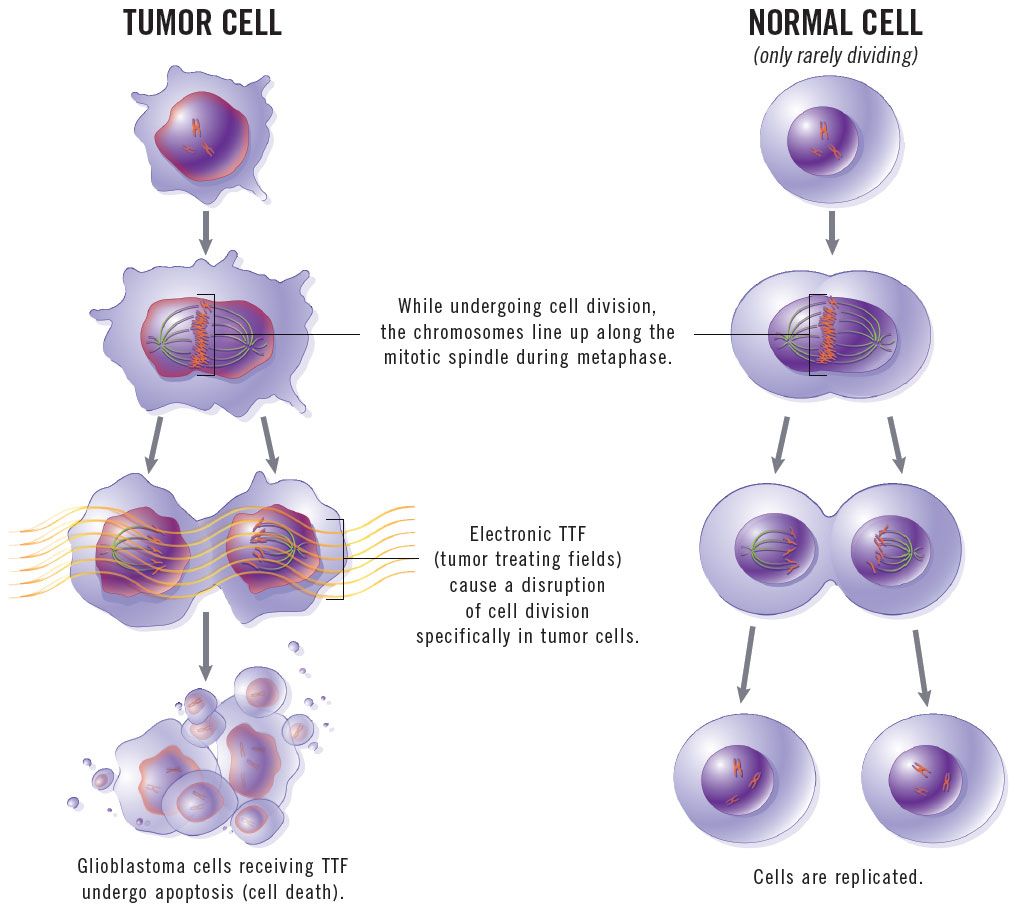Publication
Article
CURE
Medical Illustration: Novel Treatments for Glioblastoma
Author(s):
Medical illustrations by Erin Moore explaining novel treatments for glioblastoma.
How Tumor-Treating Fields Work
Optune is a device worn on the head that delivers low-intensity electrical fields, known as tumor-treating fields, directly to brain tumors.

Optune is a device worn on the head that delivers low-intensity electrical fields, known as tumor-treating fields, directly to brain tumors.
It’s a new technology never used before in cancer.
Optune works by disrupting the ability of cancer cells, specifically, to divide and multiply. The fields mainly affect cancer cells because they divide much more frequently than normal cells. If a cell isn’t dividing, an electrical field will surround but not pierce it. However, during division, cells are polarized, making it possible for the current to cut through them, damaging their DNA and destroying them.
The dividing cells can only be pierced if they are lined up with the electrical current, and this doesn’t always happen immediately with Optune, since cells may rotate a bit, moving out of range, during the division process. Patients wear the devices 18 hours a day so they’ll have the best chances of targeting the most cells.
How Tumor-Treating Fields Work

Rintega (rindopepimut)
DESCRIPRintega (rindopepimut)ION

Glioblastomas are difficult to treat because they contain an enormous variety of cell types. There is, however, a growth factor mutation, EGFRvIII, that is seen in about 30 percent of glioblastomas, but not in healthy cells. The Rintega (rindopepimut) vaccine targets this mutated protein, teaching the immune system to recognize and attack any cells that contain it.
The vaccine is made for each patient by combining tumor cells with synthetic peptides designed to stimulate an immune response to EGFRvIII.
Also being developed is a different approach (ICT-107) that harvests a patient’s immune, or “dendritic,” cells and exposes them to antigens that are often expressed in glioblastoma. Back in the body, these treated cells draw attention to the cancer-causing antigens, stimulating the immune system to fight them.
CAR T-cells
CAR T-cells

Chimeric antigen receptor T cells (CAR T cells) are immune cells taken from patients, genetically engineered to include a viral vector designed to seek mutated cells, and reinfused.
In the body, the engineered immune cells bind to mutated EGFRvIII that sits on the outsides of cancer cells. This either prevents EGFRvIII from signaling surrounding cancer cells to grow, or stimulates immune cells to secrete cytokines that kill the cancer cells.




